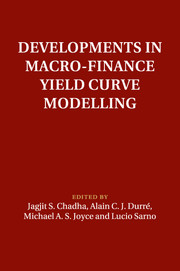Book contents
- Frontmatter
- Contents
- List of figures
- List of tables
- List of contributors
- Foreword
- Preface
- 1 Editors' introductory chapter and overview
- Part I Keynote addresses
- 2 Is the long-term interest rate a policy victim, a policy varible or a policy lodestar?
- 3 Sovereign debt and monetary policy in the euro area
- 4 The Federal Reserve's response to the financial crisis: what it did and what it should have done
- 5 Tail risks and contract design from a financial stability perspective
- Part II New techniques
- Part III Policy
- Part IV Estimating inflation risk
- Part V Default risk
- Index
4 - The Federal Reserve's response to the financial crisis: what it did and what it should have done
from Part I - Keynote addresses
Published online by Cambridge University Press: 05 February 2014
- Frontmatter
- Contents
- List of figures
- List of tables
- List of contributors
- Foreword
- Preface
- 1 Editors' introductory chapter and overview
- Part I Keynote addresses
- 2 Is the long-term interest rate a policy victim, a policy varible or a policy lodestar?
- 3 Sovereign debt and monetary policy in the euro area
- 4 The Federal Reserve's response to the financial crisis: what it did and what it should have done
- 5 Tail risks and contract design from a financial stability perspective
- Part II New techniques
- Part III Policy
- Part IV Estimating inflation risk
- Part V Default risk
- Index
Summary
4.1 Introduction
The financial crisis began on August 9, 2007, when BNP Paribas, France's largest bank, halted redemption of three investment funds. The federal funds rate spiked about 13 basis points on the day only to fall by nearly 75 basis points the next. The Fed's initial response was anemic: on August 10, the Fed announced that the discount window was “open for business”; on August 17, the primary credit rate (the discount rate) was cut by 50 basis points. As evidence mounted that difficulties in financial markets were intensifying, the Fed took bolder steps. The Federal Open Market Committee (FOMC) decreased the federal funds rate from 5.25 percent to 2 percent in a series of seven moves between September 18, 2007, and April 30, 2008; the primary lending rate was reduced to 25 basis points on December 11; and Term Auction Facility (TAF) was introduced on December 12. The Fed's next major policy actions did not occur until Lehman Brothers filed for bankruptcy protection on September 15, 2008. The Fed responded by injecting massive amounts of credit into the market, mostly through its lending facilities. Between September 15, 2008 and January 2009 the monetary base doubled. In mid-March 2009 the FOMC initiated what is commonly referred to as quantitative easing 1 (QE1), announcing that it would purchase up to $1.75 trillion in mortgage-backed securities, agency debt, and longer-dated Treasuries.
- Type
- Chapter
- Information
- Developments in Macro-Finance Yield Curve Modelling , pp. 90 - 120Publisher: Cambridge University PressPrint publication year: 2014
- 1
- Cited by

